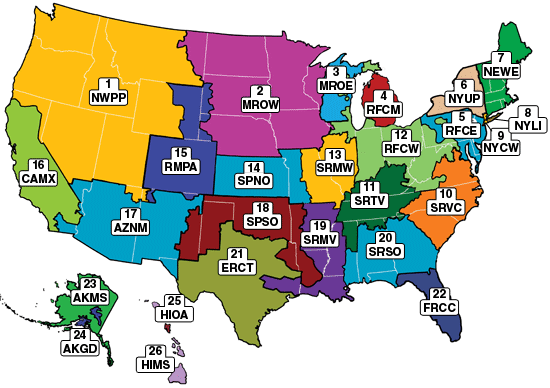Green Power Equivalency Calculator

This calculator can help you in better communicating a green power purchase to interested stakeholders by translating it from kilowatt-hours (kWh) purchased into more understandable terms, such as an equivalent number of passenger vehicles, homes, or coal plants. This calculator uses EPA’s eGRID utility nonbaseload emissions rates and should not be used to determine the emissions associated with your conventional electricity use.
Step 1: Identify the Region where Your Green Power (Purchase) was Generated
To best estimate the environmental equivalency of your green power purchase, you will need to know the geographical location and respective contribution in kWh of each renewable generation facility ( e.g. wind farm, onsite solar project etc…) associated with your green power purchase. If you do not know the location or respective kWh contribution of each renewable generation facility , advance to Option 2 under Step 2 below.

Note: EPA’s Power Profiler tool can aid you in identifying the correct subregion for facilities that fall near subregion boundaries. To use Power Profiler, you will need to have the renewable facility’s zip code and the utility name to which the generation facility is grid connected. Power Profiler identifies the correct eGRID sub region above the green table after you have selected the zip code and utility.
Step 2: Input Data & Calculate Results
This calculator offers two choices for entering green power data:
Option 1: Match each renewable generation facility to a subregion using the map above; input the kWh contribution of each generator under the correct subregion (use the number or four-letter code) in the table below and click the calculate button. The total kWh across all subregions should equal the total amount of your green power purchase. If you do not know the location or respective kWh contribution for each renewable generation facility, advance to Option 2 below.
Organizations should review the making environmental claims section of this web site before making claims associated with a green power purchase.
If you have Javascript disabled in your Web browser, please refer to the following Web page for the calculations, methodologies and references used in the online calculator. For further questions about this calculator, please contact James Critchfield (critchfield.james@epa.gov or 202-343-9442).
The above calculator is based on the Greenhouse Gas Equivalencies Calculator found on EPA’s Clean Energy Web site. The Green Power Equivalency Calculator has been customized to accommodate data input requirements for green power purchases and onsite renewable energy systems.
![[logo] US EPA](https://webarchive.library.unt.edu/eot2008/20081109104755im_/http://www.epa.gov/epafiles/images/logo_epaseal.gif)